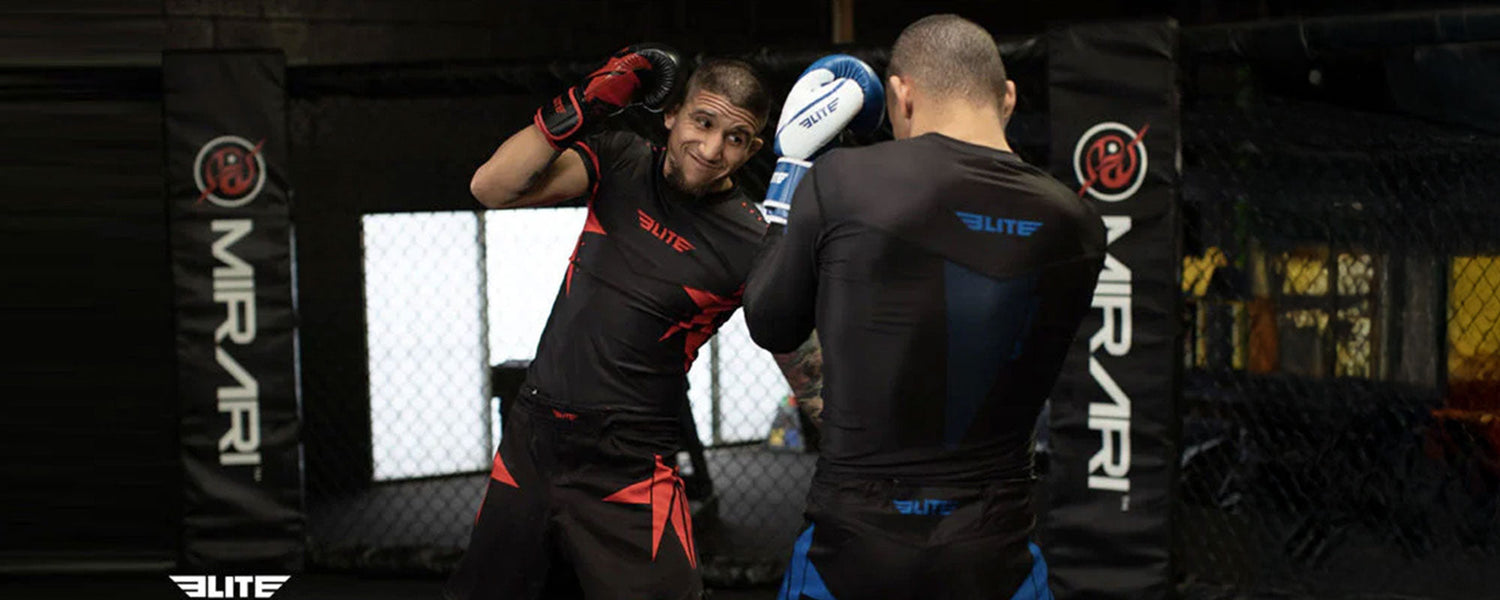Table of content
We get it, boxing is a healthy and entertaining sport that offers a wide range of physical, mental, and social benefits. Seeing these great perks, boxing is becoming an exciting new trend among people of all ages.
It’s an exciting martial art that can get the adrenaline rushing in your veins, make you feel more alive, and build ultimate mental toughness.
When a beginner decides to pick up gloves and step into the ring, they are most likely to be confused after seeing a variety of options to train for boxing.
If you are looking for the most effective methods to train for boxing then congratulations because you have landed just at the right place.
Here we will be discussing some of the best ways to start boxing training for beginners.
1. What Does Training for Boxing Mean?
In the world of boxing when we talk about training for boxing, it’s the training routine boxers follow before a fight.
Professional boxers train more than four hours a day when they are training for a fight. It helps them to prepare their mind and body for facing the opponent.
During this period, boxers follow a strict diet to properly fuel their training and maximize post-recovery. If you are a beginner boxer and want to effectively train before a fight then follow these steps.
Also read: Boxing 101, Best Punches Workout
1.1. Train Your Arms
In boxing, you primarily rely on the strength of your arms. This brings us to the first step in training for boxing that is focusing on training your hands by practicing different punches and strengthening your arms.
1.2. Focus On Your Punching Skills
If you think that your punching skills are up to the mark and you don’t need to focus much on them then you are mistaken. You must know that perfection is a myth when it comes to boxing.
All professional boxers practice punching skills throughout their career because they know that there is always room for improvement.
Power punches, deadly combinations, knockout punch, and counter-punching are the highlights of the whole game.
There are four basic punches in boxing; jab, cross, hook, and uppercut but, there are unlimited combinations that you can create with these basic punches.
1.3. Practicing Punching Combinations

Every boxer has his favorite combinations for punches. You should find what are your most lethal punches and then create a combination out of them.
If you are not sure what your strong punch is yet then don’t worry, here are some basic boxing combinations that you can try.
- Jab- Right cross (1-2)
- Jab- Cross- Left hook (1-2-3)
- Jab- Jab- Cross (1-1-2)
- Jab- Cross- Left uppercut- Cross (1-2-5-2)
- Jab- Right uppercut- Left hook- Right hand (1-6-3-2)
2. Tips On Improving Punching Power
Punching power is a crucial component in boxing. For many boxers, it can make the difference between victory and defeat. But, harnessing power is not as easy as you think.
You need to perform some technical exercises to improve your punching power in less time. Here are some exercises you can try to improve your punching power:
2.1. Medicine Ball Throw
This exercise is based on the factor of the explosion of your arm muscles which eventually results in increased punching power.
- Lie on your back holding a heavy medicine ball in your hand.
- Throw the ball in the air as high as you can.
- Use force from your arms and chest to push the ball.
- Catch it as it comes down.
- Repeat the movement for 1-2 min.
2.2. Killing The Heavy Bag
Practicing punching on a heavy bag is the basic training method that is used by every boxer.
There are various methods for training with a heavy bag, but to train specifically for power, we will be adopting a different approach.
Make sure that you use some fine-quality boxing gloves for hitting the heavy bag.
- Hit the heavy bag using any combination of jabs, hooks, and uppercuts.
- You must punch the bag as hard as possible.
- Hit one combination for a 10-second interval, then take active rest and throw in other punches.
- Complete 7-10 sets for each combination.
2.3. Shadowboxing
You may not believe it but shadow boxing also plays an important role in increasing your punching power.
It’s because while shadow boxing you can focus on the right punching technique and form which in turn can improve your punching power.
2.4. Other Tips to Improve Punching Power
- Rotating torso while punching
- Doing chin-ups
- Train your shoulders
- Keep both feet on the ground while punching
- Don’t overextend while punching
2.5. Try Slow and Smooth Boxing Drills

When training for boxing, once in a while you should try to do slow and smooth punching practice. To increase the effectiveness of slow punching you should try slow sparring with your partner or coach.
Slow sparring has the following benefits:
- Improve reflex actions
- Increase the chances of landing punches at your opponent
- Helps in unlocking your new fighting skills
- Allows you to develop a higher variety of better counters
3. Working On Lower Body and Footwork
Your punching skills and combos won’t be effective if you don’t know how to get in a position to deliver your punches with the highest chances of hitting the opponent.
Boxers with good footwork have a higher chance to outpower their opponent even if they are stronger and taller. If you have developed your footwork skills then you can maneuver yourself easily around the opponent.
When you are constantly moving in the ring then you can find dominant angles to attack the opponent, unlike always attacking through the centerline.
3.1. Ways To Strengthen Your Legs For Boxing
For improving your footwork, the first thing you need to do is to strengthen your lower body. The three main principles in leg strength in terms of boxing are:
- Muscular endurance
- Explosiveness
- Speed and agility
So, let’s take a look at some ways you can achieve all these 3 aspects for stronger legs.
3.2. Muscular Endurance
Slow Running On-Road
Slow-running is an effective way to improve muscular endurance for your legs. You can do slow running for longer periods as compared to fast running or sprints.
This allows your leg muscles to work under continuous impact for more time, which is beneficial for improving endurance.
Make sure that you don’t overdo slow-running as you will be impacting the slow-twitch muscle. Due to their overactivation, you can end up losing your running speed permanently.
Boxer’s Jumping Rope
If you know how to skip the rope using boxing footwork then it’s well and good. Jumping rope is a great way of building leg endurance.
Don’t worry if you can’t skip the rope like a boxer, you can try normal rope skipping to improve your endurance.
3.3. Explosiveness
By explosiveness, we mean the ability of any muscle to exert a maximum level of force in the shortest time.
It’s not only required for boxing but also for other sports like cycling, swimming, gymnastics, etc.
Boxing demands to make quick and unpredicted movements to establish dominance over your opponent. It’s only possible when you have good explosive power.
Here are some ways that can improve the explosiveness of your leg muscles:
Weighted Squats
Squats are a very beneficial exercise for improving explosiveness. They work for strengthening your quads, hamstrings, and glutes which in turn increases explosiveness.
Make sure that you don’t use extra heavy weights and focus on increasing repetitions instead of increasing weight.
Plyometric Exercises
Plyometrics are those exercises in which you exert maximum force in a minimum amount of time. Most of them work on strengthening your lower body.
Some examples of plyometrics are:
- Box jumps
- Skater lunge
- Donkey kick
- Frog jump
3.4. Speed and Agility
To easily change directions during a fight, duck and weave at the right moment and move around the opponent to find his weak side requires speed and agility.
Quick reflexes, fast footwork, and precise coordination are what make a boxer stand out in the ring.
Let’s have a look at some of the best leg exercises to train for speed and agility.
Shuttle Runs
This is a very effective exercise to improve your speed. It involves short and intense bursts of speed to improve acceleration.
In shuttle runs, you sprint for a short time, quickly change directions and sprint back to starting point.
Lateral Plyometric Jumps
This exercise helps in building balance and coordination in addition to explosiveness.
It allows you to improve your lateral movements inside the ring. They are also beneficial for improving the health of the knee and other joints in the lower body.
4. Preparing Yourself for a Fight
4.1. Eating Nutritious Foods
While you might be having cheat days in the normal routine and not giving much focus on your diet, you must follow a strict diet prior to a fight.
Your diet should contain foods from these three food groups:
- Complex Carbs: Whole grain, fruits, oats, vegetables, rice, etc.
- Protein: Meat, fish, dairy, tuna, beans, etc.
- Healthy Fats: Nuts, seeds, olive oil, etc.
Before you start training, you should consume food that can fuel your body for a high-intensity workout. A large portion of pre-workout meals should consist of carbs.
For the post-workout meal, you should be taking the right amount of protein according to your body weight and some carbs as well.
A boxer usually takes up to 5 meals daily, 3 are the regular ones, and the other 2 for pre- and post-training.
4.2. Shadowboxing In the Ring
No doubt, shadowboxing is one of the best ways to perfect your boxing form and improve your punching accuracy.
All professional boxers incorporate shadowboxing in their routine boxing workouts due to the vast range of benefits it has to offer.
Here are some key benefits of shadowboxing
- Improve your form
- Discover new techniques
- Improve muscle memory through repetitive movements
- Improve your balance
- Relief that build-up stress before a fight
4.3. Learn From Other Boxers
The last moment’s advice is always beneficial. You can learn some new techniques by critically watching boxing matches.
Feel free to spar with some senior boxers at your academy and ask for constructive criticism after the fight.
Don’t try to fall for a technique that you have never practiced before because you can’t execute it perfectly at the time of the fight. Only learn different ways to improve the techniques that you perform normally.
4.4. Working On Upper-Body Strength
Having a strong chest and back is crucial for boxing. Your opponent is more likely to attack these areas because they are most exposed.
A strong core builds power and strength for defensive as well as offensive movements. The core also plays an important role in generating punching power.
You can incorporate different exercises to improve your upper-body strength. Some of these are given below:
- Pull-ups
- Push-ups
- Crunches
- Superman exercise
- Planks
- Dips
- Variety of stretching exercises
5. Takeaway
As a beginner, you might get confused seeing different training plans and not knowing what works for you.
Incorporate these tips and exercises to train for boxing, and you will be able to effectively prepare yourself for the upcoming fight.
In addition, these tips can also help you in finding the right training pattern according to your boxing style.



Leave a comment
This site is protected by hCaptcha and the hCaptcha Privacy Policy and Terms of Service apply.